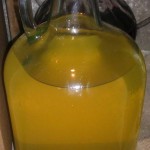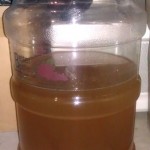Sometime last week, I wanted to speed up the process of clearing my mead using some agents. I had bentonite and gelatin on hand so I used them separately in two different carboys.
One was a gallon that I had racked off the larger amount a few months ago to condition on oak.
The second carboy was the rest of the medium show mead that hasn’t been altered in any way.
Well, the results are in and here are some photos to show you what the mead looks like today.
The bentonite worked great. The mead is not only clear, but appears to be a different color. In the matter of a few days, the mead went from an amber color to a light yellow color.
The gelatin results did not fare as well.
It looks pretty much the same as it had before I added the gelatin. The clarity and the color are similar if not exactly the same as they were before I added the gelatin.
If you would like to the what the meads looked like before I added the agents, you can see pictures of the start of my mead clarifying experiment on this post.
So what does this mean really? Does this mean that gelatin doesn’t work as a clarifying agent and bentonite does in all cases of mead? Well, I can’t say that for certain. I can say in this experiment, there is no comparison. The bentonite really worked and the gelatin really didn’t.
It is interesting to note that bentonite removes positively charged particles as gelatin removes negatively charged particles. Maybe the cloudiness in my meads was caused specifically by positively charged particles and that is why the bentonite worked so well. I know Mike has used gelatin in fining his beers and it has worked wonders when he has used it. Again, there may be a difference between the particles in mead and the particles in beer.



Mike
I think what you are seeing here is that bentonite has a negative charge in wine, whereas gelatin is positively charged. Proteins suspended in your must are negatively charged and will be attracted to the bentonite. Where gelatin is normally attracted to tannins and polyphenols. Because the bentonite seemed to have worked better it would appear that your haze was protein based (yeast perhaps) and not tannin based. (Being a mead where would the tannins have really come from really.)
Gelatin itself is a protein and can throw its own haze when used in the wrong application.
And interesting experiment would be to apply some bentonite to the gelatin treated wine and see if you can clear the gelatin and other protein based haze.
Also all theses clarifying agents work best at cold temps.
BBB (@BmoreBistroBeer)
Out of curiosity, why try to speed up the clearing process?
John
Hey BBB,
I needed to reclaim some carboys. It was either speed up the clearing or delay my brewing plans for an indefinite time. I needed the carboys for the plan.
RebelofMars81
Are y’all meaning bentonite clay? And what is the measurement ratio?
John
Yes, clay. For my mead, I added 2 teaspoons to 1/2 cup water at 140 degrees F / 60 degrees C to make a slurry. After it cooled to room temperature, I added it to my carboy. It worked very well – my mead was very clear in a couple of days.